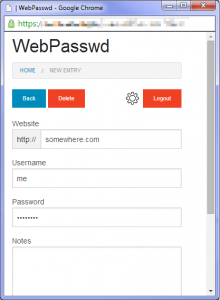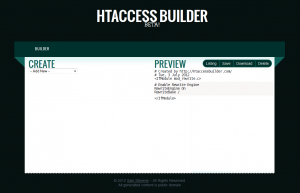Search
Archives
- August 2015 (1)
- September 2014 (1)
- June 2014 (2)
- January 2014 (1)
- September 2012 (1)
- July 2012 (1)
- April 2012 (1)
- January 2012 (2)
- June 2011 (2)
- November 2010 (1)
- October 2010 (1)
- May 2010 (2)
- April 2010 (1)
- December 2009 (1)
- November 2009 (1)
- August 2009 (1)
- June 2009 (1)
- April 2009 (1)
- January 2009 (5)
- December 2008 (1)
- November 2008 (1)
- August 2008 (3)
- July 2008 (3)
- June 2008 (1)
- February 2008 (2)
- January 2008 (1)
- November 2007 (2)
- September 2007 (1)
- July 2007 (1)
- May 2007 (2)
Categories
Meta
Category Archive: Programming
Subcategories: Bash C# Javascript Php
WebPasswd
 WebPasswd is a password app that I have been working on, its a self hosted PHP app, that stores usernames and password (along with notes) in an encrypted file.
WebPasswd is a password app that I have been working on, its a self hosted PHP app, that stores usernames and password (along with notes) in an encrypted file.
I’ve released it under the MIT license and available on github at https://github.com/sam159/WebPasswd
PKCS#5 Padding with PHP
Here is a quick class for dealing with PKCS#5 style padding.
This padding is useful for encrypting data with DES/AES which have a multi-byte block size. MCrypt will by default pad out to the next block boundary with Null bytes which will show up in the decrypted data.
A good explanation can be found here.
class PKCS5Padding {
public static function Pad($unpaddedString, $blockSize) {
$additionalChars = $blockSize - strlen($unpaddedString) % $blockSize;
$char = chr($additionalChars);
return $unpaddedString.str_repeat($char, $additionalChars);
}
public static function UnPad($paddedString) {
$additionalChars = ord(substr($paddedString, -1, 1));
return substr($paddedString, 0, -$additionalChars);
}
}
//Example use. $td is the resource returned by mcrypt_module_open
$paddedData = PKCS5Padding::Pad($data, mcrypt_enc_get_block_size($td));
PHP: Dpi of a png image
I recently needed to determine the DPI of a set of PNG files (so that I could convert the size to points), with the exception of imagemagick there is no way to do this.
So here is a pure-php method of extracting the DPI from a PNG file, it searches for the pHYs chunk (which may or may not exist).
function read_png_dpi($source)
{
$fh = fopen($source, 'rb');
if (!$fh)
return false;
$dpi = false;
$buf = array();
$x = 0;
$y = 0;
$units = 0;
while(!feof($fh)) {
array_push($buf, ord(fread($fh, 1)));
if (count($buf) > 13)
array_shift($buf);
if (count($buf) < 13)
continue;
if ($buf[0] == ord('p') &&
$buf[1] == ord('H') &&
$buf[2] == ord('Y') &&
$buf[3] == ord('s'))
{
$x = ($buf[4] << 24) + ($buf[5] << 16) + ($buf[6] << 8) + $buf[7];
$y = ($buf[8] << 24) + ($buf[9] << 16) + ($buf[10] << 8) + $buf[11];
$units = $buf[12];
break;
}
}
fclose($fh);
if ($x == $y)
$dpi = $x;
if ($dpi != false && $units == 1) //meters
$dpi = round($dpi * 0.0254);
return $dpi;
}Htaccess Builder
Here is a new tool for creating those often frustrating .htaccess files. It has the catchy name of Htaccess Builder and has been created by yours truly.
It is still in beta (like all great web 2.0 things) and I am looking for input to improve and expand it.
At the time of writing you can (not an exhaustive list):
- Mass redirect urls
- Redirect domains
- Map urls to an index file (for fancy/pretty urls)
It has a Uservoice page at https://htaccess.uservoice.com for any and all input, so please let me know what you think and what’s missing that you would like to see.
Spotify Notifier
Spotify is my music player of choice and naturally I want to be able to know what I’m listening to without bringing up Spotify.
At work this is no problem as macs have growl (yes, iMac at work :). At home I have a Windows machine, although while there is growl for windows, Spotify doesn’t use it :sadface:
Solution? Write my own notifier of course, made possible by the fact that Spotify has the current track in its window title.
Long story short, it does this:

Fades in, and fades out again when a new song is playing. It also remembers its position when closed.
Its not configurable, changes to fade speed, time etc. would need to be done in code.
Written in C# with VS2008, source available via GitHub.
ClickOnce install/launcher: ClickOnce (click launch rather than install)
Traditional Installer: SpotifierNotifier-1.0.1.2 (Zip) (RAR)
New in version 1.0.1 21/05/2012 (Thanks to Petter Östergren for suggesting improvements)
- Popup can now be resized
- Popup remembers position/size when moved rather than closed
- Should not steal focus
New programming slang
Some of my favourites:
Heisenbug
It is an error, which disappears or alters when it is attempted to be identified by analogy to Heisenberg uncertainty principle in quantum physics.
Reality 101 failure
The program (or more likely feature of a program) does exactly what was asked for, but when it’s deployed it turns out that the problem was misunderstood and the program is basically useless.
Protoduction
This is a prototype that ends up in production.
Megamoth
MEGA MOnolithic meTHod. Usually, it stretches over two screens in height and often contained inside aGod Object (an object that knows or does too much). Megamoths of greater size than 2k LOC have been sighted. Beware of the megamoth!
Easy php output compression
Below is what I regard as a reliable method of doing gzip output compression.
One thing that normally breaks gzip compression is something printing/echoing before the ob_start (usually the result of an error, debug output, errant space somewhere etc…), this is where the ob_get_length and ob_flush come in.
The problem is that headers_sent is not a reliable way to tell if any thing has been output because it may still be in the output buffer, so if we flush it before hand problem solved.
0)
@ob_flush();
if (!headers_sent() && @ob_start("ob_gzhandler"))
{
doPage();
ob_end_flush();
//Probably a good idea to exit here as more output would break it
exit;
}
else
{
doPage();
}Threaded flicker-free control rendering in c#
I recently ran into a problem where a control was rendering slow enough that it caused flickering (as the screen region is cleared and then redrawn).
Looking around the ‘net I settled on rendering the control to a bitmap and then drawing the bitmap to the screen (fast operation), which is called double buffering.
(more…)
Text block clock

This is a clock that tells you the time by highlighting text in a block of text. In this case using a C# Console App. Not exactly original, but I thought I’d give it a try.
The progress bar counts the time until the next 5 minute mark.
Maximizing a print preview dialog in c#
Here is a way to get a print preview dialog (or perhaps any resizeable dialog) to be maximized when opened.
The dialog may be cast to a Form allowing WindowState to be set.
For example:
PrintPreviewDialog dlg = new PrintPreviewDialog(); dlg.Document = doc; ((Form)dlg).WindowState = FormWindowState.Maximized; dlg.ShowDialog();
